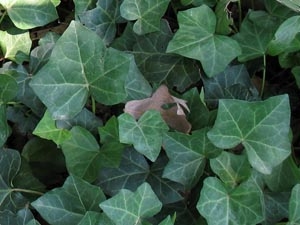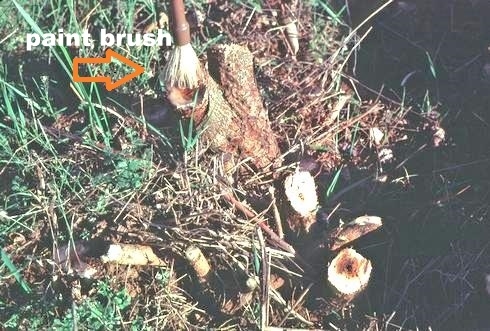Advice from the UC Master Gardener Program's Help Desk
Client's Request: Help! I want to assist my son in relandscaping his front garden to be more water-wise and child-friendly. To do that we need to remove a large area of English Ivy which has become a pest. I know that's not an easy task and I'd like to get rid of it in the least toxic manner considering the time, effort, cost, children and assorted pets. Hopefully, it also will be the easiest and fastest way. What do you recommend?
Recommendations of the UCMG Program's Help Desk: Thank you for contacting the UC Master Gardener Program of Contra Costa County about the least toxic and easiest removal of English Ivy (Hedera helix) in your son's landscape. You are wise to look for the safest way to proceed, especially with young ones and pets around.
While there are more than a few solutions to removing English Ivy (see the link below), the most successful and quickest for the home gardener (vs. outright brute-force removal) is the use of an appropriate herbicide after removing as much of the ivy as possible by physical means. That method is outlined below. The use of herbicides should only be done after reading the full instructions and taking all the precautions as cited on the label. If you have further questions on the herbicide use, there is a 1-800 number to call.

in this instance, poison oak
Treatment solutions should contain 8% to 10% triclopyr (the 8% material available to homeowners in nurseries and other stores will work fine, undiluted) or 8% to 10% glyphosate. (If using a brand that has 18% glyphosate listed in the active ingredients, make a 1:1 solution of the product and water. If the product contains 41% glyphosate, use 1 part product and 3 parts water.)
Any regrowth from cut stumps or stems can be sprayed again when the new leaves fully expand. Cut stump application of glyphosate can sometimes injure non-targeted plants of the same species in close proximity to the treated plant. This occurs via herbicide translocation through naturally occurring root grafts between adjacent plants. This type of root grafting damage depends on the species. Rarely, if ever, does root grafting occur between plants of different species. This means that it might be difficult to eradicate the ivy to a precise boundary. If this happens and is a problem for you, replanting and/or allowing some regrowth may be necessary.
This link, Woody Weed Invaders Management, will give you even more information about various additional treatments tht you might want to consider if the herbicide option is not for you. These treatments include mechanical removal, cultural control, and additional recommended herbicides and methods of application for home gardeners.
http://www.ipm.ucdavis.edu/PMG/PESTNOTES/pn74142.html
|
Woody Weed Invaders Management Guidelines--UC IPM www.ipm.ucdavis.edu UC home and landscape guidelines for control of Woody Weed Invaders. |
Help Desk of the UC Master Gardener Program of Contra Costa County (JLW)
Come to the UC MGCC Program's Great Tomato Plant Sale
Walnut Creek 4/2&9, Richmond 4/9, and Antioch 4/16
Click for locations and plant lists!
Dozens of heirloom tomatoes & vegetables chosen especially for Contra Costa
Note: The UC Master Gardeners of Contra Costa's Help Desk is available year-round to answer your gardening questions. Except for a few holidays, we're open every week, Monday through Thursday for walk-ins from 9:00 am to Noon at 75 Santa Barbara Road, 2d Floor, Pleasant Hill, CA 94523. We can also be reached via telephone: (925) 646-6586, email: ccmg@ucanr.edu, or on the web at http://ccmg.ucanr.edu/Ask_Us/ MGCC Blogs can be found at http://ccmg.ucanr.edu/HortCoCo/ You can also subscribe to the Blog (//ucanr.edu/blogs/CCMGBlog/).